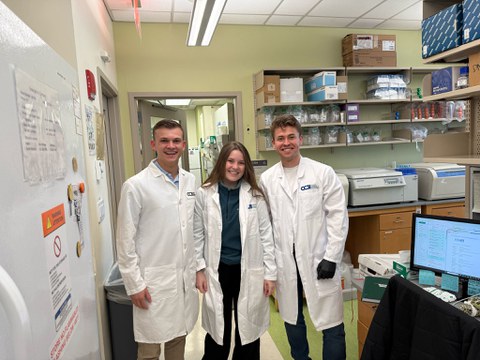May 05, 2025
Cutting-edge research and skyline: Students from the Faculty of Medicine report on the start of their research year at Columbia in New York

A year at Columbia in New York (from left): Tim Lempfer, Kim Becker and Max Boeck.
The Faculty of Medicine at TU Dresden University of Technology was accepted into the ICEP (International Collaboration and Exchange Program) at Columbia University (New York, USA) for the first time in 2024. In a rigorous selection process, three candidates were chosen from numerous applications for a twelve-month research project at Columbia University: Kim Becker (model study program) is conducting research in the field of diabetes under Prof. Karsten Kretschmar (CRTD) and Prof. Remi Creusot (Columbia University). Tim Lempfer (model study programme) specializes in immunology in the laboratory of Prof. Marc Schmitz (Institute of Immunology TUD) and Prof. Emmanuel Zorn (Columbia University). Max Boeck (regular study program) is dedicated to the field of transplantation under the supervision of Prof. Barbara Ludwig (MK3) and Prof. Greg Nowak (Columbia University). The three students have now been in New York since the beginning of April 2025 and can report on their first experiences: from cutting-edge research and the lively city life around them.
After much anticipation and intensive preparations, we have now been in New York for almost four weeks. The first time has been an exciting mix of new scientific challenges, personal discoveries and the excitement of living in one of the most dynamic cities in the world.
The city is bursting with life. Even in the first few days, we learned to appreciate the diversity, cultural richness and vibrant life. A walk from our apartments in Harlem along Broadway to downtown illustrates the diversity of this metropolis - along the numerous small delis and vegetable stands in Little Dominican Republic, across Central Park and Columbus Circle, along the large theaters for which Broadway is known, to the skyscrapers of downtown, Times Square and the Empire State Building.
The people here are friendly, helpful and open - whether in the lab, when shopping or on the street. We are particularly struck by how many people here speak Spanish. It is not unusual for Latin American songs to dominate the background noise on the streets. We do a lot of sport in our free time. The city offers many publicly accessible sports facilities, especially basketball courts, but also running tracks and artificial turf for football, soccer and lacrosse. There are also numerous interesting running routes, such as the loop around Central Park.
As part of the ICEP program, we work in the laboratories of Columbia University Irving Medical Center – one of the leading medical institutions in the USA. The laboratory conditions are excellent: modern, well organized and with access to the latest technologies. The scientific supervision is also of a very high standard. You quickly realize that cutting-edge research is being conducted here and it is very motivating to be part of it. We are in the middle of our induction – long days in the lab are part of the program, as we learn a variety of different techniques in a short space of time. This is necessary as we have all been given our own projects – you quickly need a certain amount of independence for this.
Our research projects are as varied as they are exciting.
Kim works in the Creusot Lab. This specializes in research into the development, prevention and treatment of type 1 diabetes. The team develops new therapeutic approaches to restore immune tolerance and investigates these in various mouse models.
Max works in the Nowak Lab, which focuses on xenotransplantation, i.e. the transfer of tissues or organs between different species. The aim of his project is to investigate the innate immune system and in particular the role of macrophages in a xenogeneic environment. The close integration of basic medical research with practical work on animal models is particularly exciting.
Finally,Tim works in the Zorn Lab with a focus on heart and lung transplants. In various projects there, he investigates the mechanisms that can lead to transplant rejection. Of central interest here is the role of previously poorly understood polyreactive antibodies.
Special highlights outside of our work so far have been visits to a New York Yankees baseball game and the American Museum of Natural History. Even though we hardly understood anything about the baseball game at first, the atmosphere in the stadium was rousing and typically American: loud, colorful, full of energy.
The Museum of Natural History, on the other hand, is huge and offers an incredible variety. From dinosaurs to the oceans, space, the history of mankind - everything is covered here in huge halls.
Of course, living in New York also comes with its challenges. Costs, especially for food, are high - even simple purchases at the supermarket can quickly become expensive. And then there's the traffic: constant honking is apparently part of everyday communication here. It took some getting used to at first, but we now accept it with a smile.
Overall, we can look back on the first four weeks with great satisfaction. We are looking forward to the time ahead, new scientific findings, personal experiences and many more exciting impressions in this unique city.
Many greetings back home
Kim, Max and Tim
